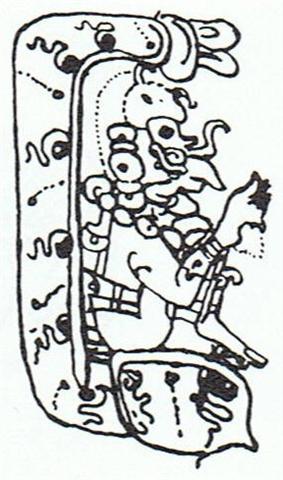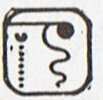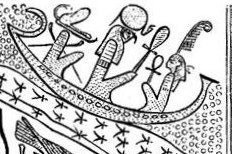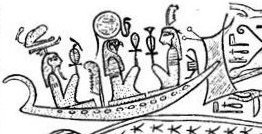2. The reason I am using so much space and time to look at and discuss pictures from other places than Easter Island is my conviction that the ancient language of signs was 'international'. It was used wherever agricultural society had been introduced and accepted. The rongorongo signs are only outlines and not always easy to 'look through', therefore we need comparisons from societies which were more 'eloquent'. Beyond midsummer a 5th Rain God figure shows how he has gone down into earth, how he is sitting down inside a kind of 'cave' (formed like the letter C):
The cave is designed like a sign of earth turned up - cfr the horizontal 'henua' sign trodden upon by the 3rd figure above - with its 'tail' forming a roof and its 'head' forming a floor. The 'floor head' is separated from the rest and presumably a continuation (a reflection) of the monster head at bottom of the tree. Inside this 'cave of earth' there are 6 Caban signs (and inside the separated floor head there is an additional one):
As always in the following I have reversed the Maya pictures to get the front side at right. In order to 'prove' Caban means earth I present a glyph where both Sky (Caan) and Earth (Caban) are drawn:
Between the upper sign Sky (Caan) and the lower sign Earth (Caban) there is a gap (maybe indicating spring), and this gap seems to be the origin of midsummer. The 'eyes' in front are drawn as if they were looking back, and we can compare with the dark last month of the year (Vayeb) with only 5 days, where they are depicted as if looking ahead. A double rim is starting to form, cfr how the 'Sun egg' in the night develops a yolk:
From this evidence it is reasonable to use the 'international sign language' to explain the peculiar vai sign in Aa2-37, it is probably meant to indicate the development of a Sun 'yolk':
The surrounding glyphs support such an interpretation. For instance is in Aa2-31 the sky (ragi) still without any light (signs of Moon crescents), but the time of waning (reversed kai) is now in the past and the time of growth lies ahead (kai at right). A turnover (viri) is confirmed by the numbers, but not from the front side to the back side (as in G) but from the back side to the front side:
|



















